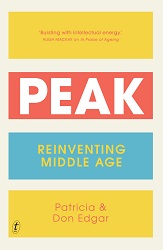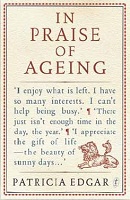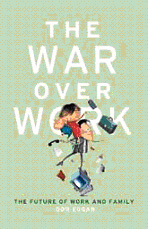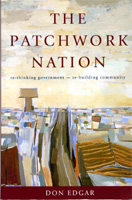
Patricia Edgar & Don Edgar

THE TRAPS OF OLD AGE
Don Edgar
Introduction:
We have written before on age discrimination and unnecessary intergenerational conflict. Patricia has written a book called 'In Praise of Ageing', using exemplars of remarkable people growing old 'gracefully', of being fit and active until well into their nineties. They were true outliers, and models of positive ageing, but certainly not typical of most people we now know who, like us, are over the age of eighty. Together, we wrote another book on the demographic shift in middle age to 50-75, what we called? 'PEAK: reinventing middle age', using examples of people who have refused to 'retire' and moved on to other fields as engaged citizens of a changing society. The nonsense of thinking of middle age in your forties and planning to retire by 65, was shown to be a wrong-headed way to deal with people who are a huge national resource. We have decried age discrimination in all its many forms, showing that 'old age' does not begin at 50, and many people over that age still have much to contribute to society as a whole.
Now in our mid-eighties, we are forced to take a clear-eyed, perhaps more realistic, view of what it actually means to reach the 'old old' years and examine the choices to be made within rather limited options. They are not 'the golden years', or 'the best years of our life', as one of our friends claims. Without wanting to merely whinge about the pains and perils of living a long life, we conclude, not surprisingly, that unless you continue in good health, have adequate finances, and have around you positive family support, you face a series of traps, brought about by the decline of extended family life and increasingly government-controlled but marketised old age policies and programmes. Money is the key, but we believe the entire edifice of 'aged care' needs rethinking and change.
The nature of ageing has been transformed by broader societal shifts. The notion of a 'working age' group having to produce enough revenue for an older group of 'dependants' rests on a false base, though 'growth' economists will have it no other way (witness places like Japan, China, Europe with ageing populations cf. Africa with huge youth cohorts who will, given the right education, etc, become more productive and influential) It was Otto von Bismarck who (at the suggestion of the German Kaiser) introduced the first 'pension' scheme for people over the age of 65 (in fact it was initially 70) who were 'unable to work for reasons of age or disability'. Back then, most people started paid work after minimal schooling, mostly in jobs requiring physical fitness and stamina, and their life expectancy was in the 60s, so few would have been eligible for the pension in any case; it would not have been a burden on State coffers. Yet now, when we face a 100 year lifespan, we still stick to an arbitrary 'working age' definition of 15-65, in a time where most young people are still in education at age 15-25 and life expectancy has risen to the 80s. Public policy definitions are hard to shift, so as our population continues to age, economists and demographers began talking about a 'dependency ratio' of working age people having to support older 'dependents'.
At the same time, there have been profound shifts in the workplace and in family life. Women were not expected to enter the paid workforce once married, their role being confined to raising children and caring for the family, including the elderly. Once the capitalist market system moved to a consumerist focus, and the service economy became the norm, more women entered and stayed in the paid workforce. They were better educated, had fewer children and dropped (or rather transferred to others) much of their traditional caring role. Social values shifted towards the rights of the individual and away from community service and reciprocal responsibilities; offspring left the family home to lead an 'independent life', the old institutions of church and community faded away as moral influencers and the aged got shunted off as a damned nuisance - into nursing homes, aged care accommodation, lifestyle villages where old and young rarely mixed.
As a result, aged care policy has been guided by a 'ghetto' mentality, one where the goal is to shift old people out of the public eye, either shut up alone in their own homes, with a little 'help', or shoved into aged care institutions at minimal cost, with largely casual and poorly-trained staff, locked doors and appalling food. Policies designed and administered by bureaucrats who are themselves not yet old and have little understanding of the needs of the very old. Aged care services are the epitome of ageism itself; and since more women survive into old old age than men, it's actually a question of sexist ageism, policies and programs designed by younger people who have yet to feel the effects of real old age,
Government provision for the old was largely privatised as a lucrative market opportunity, open to financial exploitation. Aged care, indeed the study of 'care', became a specialised study, with inadequate short courses bringing in strangers to look after the unwanted old, with scant accountability or enforcement of quality standards. Carers were offered minimal pay, so standards of care declined and people began to demand a better system. Ageing in place became the new mantra, so 'aged care packages' were offered to better suit the needs of old people, but budgets limited their availability and once again the market began to operate in favor of 'providers' charging administrative fees rather than in the best interests of old people as consumers/clients. The recent Royal Commission into Aged Care identified serious problems in the system, some incremental changes, but called for reform still within the dominant paradigm of sequestration and treating the aged as a problem for the budget, not as an essential human need. Yet we still have the Director of Uniting Care Australia insisting 'Boomers must pay more for their age care'.
This neo-liberal shift to the sequestration of older people has produced several unwelcome changes in their wellbeing and has exacerbated inter-generational conflict which undermines any sense of reciprocal responsibility for the aged. This paper calls for a change of thinking about the very old. It calls for a re-valuing of our elders and an end to schemes which push them out of the public eye.
Chapter 1: /Keep on keeping on? - Bodily breakdown
It's characteristic of younger people that they assume they will continue to be healthy and fit long beyond what the body itself decides to do. Not everyone, like Elon Musk and Richard Branson believes they can slow down the ageing process and never die, but it's a trap in thinking that we all fantasize about. Even in our seventies both of us were capable of doing most of the physical things we had always taken for granted.
We all think we can keep on keeping on, reluctant to admit to any deterioration in strength and daily abilities. But accidents do happen along the way; cancer is no respecter of age, and our body's cells do deteriorate. The myth that cells in the body are replaced every 7-10 days does not mean we can live forever. Cells that have to do a lot of hard work are replaced regularly: blood cells last an average of 120 days; colon cells are replaced every 3-5 days, skin cells rejuvenate every 2-4 weeks, stomach cells last up to 5 days, and our bones regenerate constantly, taking up to 10 years for full replacement. In contrast, the cells of our cerebral cortex and of the cornea in our eyes stay with us from birth to death, though their longevity probably explains why poor eyesight and dementia can still set in as we age.
Most of us struggle with bodily deterioration of some sort. Don's eyesight, hearing and muscle strength lasted well into the 70s, but Patricia's hearing began to falter in her 60s and psoriatic arthritis crippled her toes and hands. Up till then, Don did most of the shopping, cooking, gardening, chores, car driving, etc; Tricia did all the clothes washing and house organising; we both could handle our business affairs. But rheumatoid arthritis began to cause physical problems for Don in the late sixties, then cancer and a stroke led to invasive treatments and limits to what either of us could manage.
There is no way young people can imagine what it feels like to be in constant arthritic pain, to not be able to read the small print or hear conversation in a noisy room, to be unable to open jars easily or climb a stairway without handrails to give security. We never cease to be amazed at their assumption that we can keep on keeping on despite our obvious ageing and increasing inability to do what we used to do without a thought. Society's obsession with diet and exercise is reinforced by the media and medical practice aimed at the avoidance of chronic conditions. Cigarette smoking, alcohol consumption and lack of regular exercise are well known contributors to disease and premature death. Yet they provide some relief to those who do have pain or discomfort and follow social class inequalities in financial and emotional wellbeing.
Recent research on low-grade inflammation and the role of gut microbiomes suggests that a good diet (perhaps Mediterranean?) regular exercise, no smoking and less alcohol will keep us fit and anyone who ignores such good advice may 'deserve what's coming'. Ironically, many of the diseases of modernity (heart, cancer, etc.) are caused by new environmental factors such as air pollution, plastic and Teflon particles in everything, asbestos, chemical sprays and glues in flooring, etc., so the advances in medical science are countered by factors over which we have less control individually. (Reference and quote??) No one tells you about how common diseases like arthritis (often caused by the very exercise we are told to do) can ravage the body and make even simple tasks feel painful. My physio tells of a 50-year-old man who, as a child and youth, swam every morning to keep fit. He now has both shoulders wracked with osteo arthritis, severe pain and can barely cope with daily chores.
We are bombarded with (often contradictory) advice on diet and what foods harm the body, but our whole system of consumerism makes obesity and diabetes more common, with crises such as strokes or heart attacks occurring even in the fittest of people. Then what?
I was healthy and very fit until my late seventies and then lymphoma cancer treatment and a stroke cut me down to size...Now I'm constantly tired, not allowed to drive, so am entirely dependent on Patricia for everyday shopping, visiting friends, escaping for a few minutes or hours from our suburban enclave. Getting to our beach house is a nightmare because she has to anticipate our likely needs, especially medications, pack and unpack the car (with me carrying only a few things, certainly not a heavy suitcase), then she has to drive the whole way, making for an exhausting day for us both and an increased sense of helplessness on my part. Taxis and ubers are usually out, through fear of Covid, and family visits involve an imposition on other busy members. I can walk now without crutches or a stick, but am left far behind as walking companions strike a more normal pace. The physio recommends a 'walker' to give me more balance, but it can't be used on steep hills or narrow crowded footpaths. I plan to try two hiking sticks, so I have control with both hands and not have to bend over.
I can carry parcels in both hands, but balance and avoiding obstacles is still a problem. In the park, uneven surfaces, poorly-trained dogs jumping at you, and silent bike riders whizzing past are a constant threat. Not to mention our love life. The stats show that both impotence and infertility increase with age:? 5% of men are impotent by age 40, 45% by age 60; and fertility declines by 52 % between 30 and 40. Libido suffers from drugs and pain. Some males can be fertile for longer, but women stop ovulating by the early 40s. It pays to have children when young and healthy.
Natural bodily decline with age (excluding stroke and heart attack) includes muscular shrinkage, gradual brain cell death, loss of weight, osteo arthritis, slower walking, incontinence and increasing frailty, despite the new evidence on brain plasticity. And chronic conditions tend to cluster as we age, with 41% of those over 65 reporting arthritis, a severe impairment on everyday activities. Cancer and heart disease are the most common cause of death in the 70s, overtaken by pulmonary problems in the 80s. Diabetes is on the rise as a cause of disability and death.
The latest report on prolonging life suggests there is a real limit to life - surprise, surprise!. (we are told every cell in our body is programmed to die, except cancer cells) While average life expectancy has risen to the 80s-90s, and more people live until over 100, the number of those who make it to 110 has declined. So the emphasis has to shift to staying reasonably fit and active (both physically and mentally) as we hit those older years, maintaining social contacts and purposeful activities as long as we can, and not expect to live much beyond our 90s. In particular, not to let ourselves be isolated and depressed in some age-segregated place where only old people meet.
Chapter 2: Losing your partner (if you have one)
The second trap of old age is caused by the loss of a partner. Too often we assume we shall 'grow old together', and the promise to stay 'until death do us part' is meaningless to a twenty-year-old, even less after decades of living a good life together. And with lower rates of marriage combined with high rates of relationship breakdown, made worse by many people choosing not to have children, the family as traditional support network is suddenly not there.? While the number of households has increased, the number of families has not, with over 20% of all homes occupied by one person living alone. This does not augur well for family-provided care as they age, a social norm in many non-Western countries. A privatized and managerial State is no substitute for family responsibilities and inter-dependent care
Not to overly romanticize the family as such: many old people in cultures where respect for the old prevailed were resented and relegated to a miserable life in a cupboard or the back shed, beset by uncaring offspring, with no access to good health care or income. Some early societies even had rituals for disposing of those who could no longer contribute: Eskimos/Inuit people whose elders could no longer 'chew the fat' were left out on the snow to die of cold or polar bear attack; some South Pacific Islanders would hold a feast before cutting the old person's throat or pushing them off a cliff. Early 'hospitals' were set up largely to house the old and disabled, with very low survival rates - probably better than being pushed under the stairs to die a hungry death.
Those primitive rituals were based on respect but also on a recognition of the realities. Once an old person serves no useful purpose, or has no resources to offer the group, they lose respect and the right to live. At least modern societies try to prevent elder abuse and provide some public resources to help us keep on living. The current issue is that letting too many of us survive into old old age costs 'the economy' and the ubiquitous goal of 'progress' is threatened. In most discussions, the 'working age' population is still defined as up to 65. And too often today, possessing wealth/resources such as property becomes an excuse for financial abuse, impatient for inheritance overtaking the responsibility to care. Even those put into aged care face a lonely life with few relatives or friends visiting.
Having a partner into old age is no guarantee either, though it helps. One of our friends is younger than her husband, who has some dementia and is not capable of doing much to look after himself. She recently had a bad reaction to anaesthetics from a cataract operation, fell out of bed and lay there on the floor, in pain, unable to get up. He finally sat up and asked, 'What are you doing down there?' She called for assistance from a neighbour on her mobile phone (her husband can't manage one of his own) and recovered quickly, but the realisation set in that he would be utterly helpless without her, and she can no longer cope on her own. Panic time. Many partners would be the same, unable to assist, or call for assistance. In our own case, Patricia was suddenly taken very ill by an unknown virus (not Covid). She spent 4 weeks in hospital, so I was forced to cope on my own for most of that time, with family members bucking in to help, but I realised how useless I had become, with her taking over all my previous duties. Many couples can cope together into old age, but the partner is not always there!
In contrast, several of our friends claim to have dementia, yet are functioning well. Yes, they are repetitive and forgetful at times, but manage most tasks on their own. They are reluctant to call on family or friends but know the time may come when they are unable to cope with caring alone. One in particular was recovering from a hip operation, foolishly tried to cut back some weeds growing up through her front fence, leant over to pick up secateurs, and fell flat on her face - not on grass or a soft garden bed, but onto a concrete path, smashing her glasses into her face and breaking her nose. No-one lived with her to call on for help, so she lay there until a passing pedestrian saw her and dragged her up. Every old person lives in dread of a fall, making them cautious and feeling vulnerable. In our case, putting out the rubbish bins proved dangerous. Patricia was doing it on her own, Don came out to help, with her hovering behind insisting he go back inside. The heavy bin rolled away suddenly and I fell, knocking her down with me; fortunately no bad injury but both with sore backs and new warning bells ringing. I won't offer to help with the bins again. My physio suggested I should use a walking frame, but my wife thinks I'll likely fall over with that too. We tried it out and it did give me better balance and I was able to do longer walks, fending off stray dogs in the park instead of being bowled over by them. Though it is titanium-light, it's still difficult for her to lift in and out of the car's boot. Trial and error, always anticipating trouble, more for the caring partner than for yourself. But without a partner, you're virtually helpless.
Chapter 3: Insisting on 'independent' living
Nowadays, we are told to save for our old age, superannuation being the latest confidence trick to make us think we can retire early and enjoy 'the golden years'. What of low income folk, casuals, part-timers, and women who leave the paid workforce to raise children? The reality for them is not so rosy. And super savings are not enough for everyone to buy into an aged care home, or pay for a full-time carer.
Back in 1974 only 32% of the workforce was covered by super (58% in the public sector, 24% in the private sector) and the 1992 Hawke/Keating reforms making superannuation contributions compulsory, aside from its good intentions, was a ruse to curb union agitation and stop wage inflation, rising to 9% and scheduled to increase to 12%. Women whose time in the paid workforce was interrupted by childbearing were disadvantaged. Today, the average superannuation balance for men aged 60-64 is $204,107; for women it is only $146,900, a gender gap of 28%. Try making that last until you are 90 or 100! That gender gap increases to 35% at ages 55-59, only somewhat offset by a lower wealth gap (because of higher home ownership rates at older ages). Those in casual jobs suffered in comparison to men and full-time workers, with many lower income people not being able to save for home ownership, the one 'guarantee' of having a comfortable retirement, even if relying on an inadequate government pension. Even the current tax breaks on superannuation earnings benefit higher income people, not the poorer majority, and proposed reforms will not restore much equity . (Jessica Ervine, "Is dignified retirement out of reach?", The Age, 28 February, 2023). More extreme measures like capital gains tax on the family home, and changes to negative gearing will always meet with huge public resistance.
The notion of a dignified retirement has changed a lot since the days of getting a gold watch on retirement, with higher expectations for living in a 'luxury' apartment or cruising overseas. Stamp duty on house sales reduces the capital needed to 'downsize', buy into a retirement village and still have enough capital to live well for another twenty or so years? Now there is a new push to drop stamp duty and instead apply land tax to every home, all of which assumes older people have the income or savings to pay an annual levy on their home. Such policies are dreamt up by younger advisers who have no idea of the realities of old age.
Chapter 4: Downsizing from the family home
As we get older and offspring move out it seems logical to downsize from the 'family home' and move into smaller premises. Constant attacks on 'selfish Baby Boomers' hogging larger houses at the expense of younger generations ignore the fact that only 79.5% of those aged over 65 do own a house, compared with 39% of people under 35, not surprising given the time it takes to pay off a mortgage (Don can remember his grandmother weeping when she came out of hospital after a cancer operation, because her youngest son had just made the final mortgage payment (of a few shillings) on their modest country house.) As well, fluctuating interest rates (very high in the 1950-60s, lower in recent years but now rising sharply) prevent downsizing.
Another factor in higher ownership by older people is the shift away from early marriage and child-bearing, the traditional 'family home with a backyard' not being the ambition of many singles and couples without children. Apartment living closer to inner city jobs, services and facilities is their preferred choice, with rentals soaring in the last decade and tertiary student debt making it more difficult for young people to secure a loan. But home ownership is the most significant buffer against poverty and outdated notions of taxing or pension means-testing based on 'imputed rent' make no sense if we want old people to have a dignified life.
Most people want to age in their own community, not move elsewhere, and the fact that developers have failed to design apartments suitable to older age living has made moving out of the family home an unattractive choice. A combined lounge/dining/living room, with a narrow bench kitchen space, with one or two small bedrooms leaves little room for purposeful activities. State taxes make downsizing costly, not easy to do, and younger families looking for properties with some garden and play space for children have little choice but to move to poorly-serviced outer suburbs, where planning has often ignored their needs.
We were ourselves forced to 'downsize' when drought/water restrictions meant the big garden and pool became too difficult to maintain and when we did sell we found we still needed room to live in (two offices for ongoing work) and store furniture and effects that younger family members may need once they set up their own homes. More importantly, we wanted spare bedrooms for grandchildren and visiting guests to use when needed, and it took a long search to find a suitable property. Most of the apartments had a combined kitchen/dining/living room, a mezzanine bedroom and no room for an office or hobbies unless you could afford more than one bedroom. We also decided we wanted to be closer to the CBD, and public transport, within walking distance of shops and medical services, a combination almost impossible to find. State Sales Tax was also an obstacle to selling up and moving house. But we did eventually and have lived for two decades with room to move and entertain properly. Our grandchildren and old friends can be guests without interfering too much with our own privacy. Just because you get older does not mean the end of social life and suitable planning of housing for the old is an urgent need. We could not have managed it without the help of daughters to pack up and move; it takes longer than you think and is exhausting.
Downsizing in whatever form still requires the physical ability to shop, cook, maintain a home as an independent person, not always possible as the frailties of old age take hold. Once walking becomes difficult and frailty sets in even that cannot be taken for granted. Outside help is needed, and you need adequate financial resources to do that.
Ageing is the ultimate driver of inequality in our society yet social policy continues to treat 'the aged' as one homogenous group. We are not all the same.
Chapter 5: Using strangers as carers/home care packages
Policies have improved somewhat in recent decades by encouraging old people to 'age in place' (which is what most have always wanted to do) and by providing 'home care packages' tailored to your particular needs. But such public provision is limited and not everyone has the funds to obtain even basic home help, let alone a privately-run home helper. Eligibility is tiered according to assessed 'need' (yet another lengthy bureaucratic process) and in 2022 there were 62,000 people still waiting for a package, with 97,000 currently being assessed. Even when you get a package, provision is privatized, with little quality control, and you're likely to end up with non-English-speaking, poorly-trained strangers coming in to clean the house, help you shower or do the shopping. Or if you don't speak English yourself, the hired carers can't communicate either. In theory, you can change carers and specify your own care needs, but 'providers' are rip-off merchants and good carers in short supply.
There are good stories and bad. Our daughter found one distressed woman in a post office car park, screaming that her Chinese 'carer' was stealing from her home, refusing to take her shopping and behaving in a threatening way. Another friend of ours, a carer with one of the major providers, complained of being asked by an elderly man for "a bit of jiggy-jiggy' when she visited his home, of having to clean filthy and chaotic households. Many people just wanted someone to talk to (and listen) rather than any physical cleaning or health assistance. She was good at that. But her low wages (reduced by providers taking excessive 'administration fees' out of the government package) made the job unrewarding, though she enjoyed helping most of her older clients, especially taking them out for coffee and a chat: "Most people have had interesting lives." She is a rare breed, with many old people complaining about a lack of interest and respect on the part of their casual carers. A young male carer tells us several of his clients just want to be taken out for a beer and a chat, someone who will listen, and he enjoys that too.
If you can afford to pay privately without a subsidized package, the same issues abound: shortage of qualified carers, high costs, shortcuts in care, language barriers and incompatibility of values. Pressure comes from family not to spend too much of 'their inheritance' on private helpers, like house cleaners, gardeners, etc, but what else have we worked our butts off for over a long life? Quality still matters, and finding that is tricky.
One of our friends, a well-off 102-year-old woman still living in her own home, no family helpers living in the same city, was paying for nurses to help her get out of bed, shower and dress in the mornings, help settle her down comfortably at night. As well, she paid a local hotel chef to bring her an evening meal, a gardener and cleaners once a week. On one visit, where we took her a lunch, she lamented that her "silver cutlery is going missing". Reluctant to accuse any of her 'helpers', she said they had had a hard life and had not enjoyed the luxuries of life that she had. However, on cleaning up the dishes after lunch, we found ingrained filth along her kitchen benches and neglected floors - which her impaired eyesight had failed to pick up. Not a very 'dignified' way for an elegant and intelligent lady to spend her final years, with no watchdog to plead her cause.
In the first audit follow-up to the Royal commission on Aged Care, it was found that home care providers delivered an average of 53.65 minutes per day (there is no required minimum) and average staff costs were $45 per person. Most of the 921 providers were profitable, but there is still a shortage of home care packages, with assessment for eligibility causing major delays. Profitability drives the system, and it costs. Without financial resources, you are doomed.
Chapter 6: Moving to a 'lifestyle'/'retirement' village
Once illness or frailty catch up there is little option but to be moved into old age accommodation, Not a nursing home, but a village-style complex,with 'a nice room', 'lovely surrounds' and paid carers who call you 'Luv' or 'darling' because they can't be bothered learning your name. The lovely room becomes a prison, often with a single bed, one window, one chair and no furniture you can call your own. You are surrounded by other old people, some villages refusing entry to children.
Many people opt for such a 'retirement village' before frailty sets in. Others opt earlier to move into a retirement or 'lifestyle' village, with more social activities and on-tap facilities. They have optimistic publicity, with names like 'Leisureworld', 'Sand Waves', 'Poppy's Veranda', 'Safe Harbor', 'Purple Peony', 'Elysia', 'Cherry Tree Village', 'One-hill Farm', even one in the USA called 'You-did-Good-Dad Estates'. The best offer hobby clubs, dances, gymnasiums, choirs, public speakers and excursions if desired
We saw several of our friends make this move only to find they were completely unsuited to such a 'jolly' life : court captains who interfered, tiny gardens with no view, neighbours peering over the back fence, communal dining rooms with boring food, 'activities' such as an 'Easter Bonnet Day', line dancing, pickleball (which involves leaning forward to hit the ball and the danger of falls). Not all people enjoy a singalong, or having close neighbours, a lack of privacy, and pressure from social busybodies to 'participate'.
One couple we know had shifted States to enjoy a better climate and found a 'lovely' village. But they had incompatible interests. The wife enjoyed the social activities; the husband did not, so they faced selling out and trying to buy a house in the same warm climate area. This took some time until they moved back to a proper house in their home State, close to an ailing son and his family. Another couple we know objected to our calling such places 'ghettoes for the old' and thoroughly enjoy the living environment and activities available to them. . OK if you are 'social'. It's just not the solution to everyone's needs and the quality depends on what you can afford.
Chapter 7: 'A lovely room' - nursing home aged care accommodation
Even worse than the lifestyle villages are aged care homes where you are disposed of neatly by not having any family or other carers who will (or can) take the responsibility. Many offspring think they are doing the right thing by placing older parents into 'care', and many of them are trapped in what is called 'the sandwich generation' - their own kids still at home and financially dependent, plus their ageing parents. Much of the public discussion focuses on how hard it will be to finance age care with an ageing population. In fact, most old people do not want, nor do they enter, an aged care/nursing home. Over half those over the age of 65 are over 85, two out of every five are women and it's misguided thinking: at 65, certainly at 85, most of them will want to live in their own community with visiting helpers/carers, not to pay an exorbitant price and end their days in a 'home' that feels like a prison.
The 2023 audit found they delivered an average of 187 minutes per week of care, with an additional 5.6 minutes of allied health and 9.6 minutes of lifestyle activities per day. Many have no permanent nursing staff. The median labour cost was $173 per resident per day and the average amount spent on meals was $12.40 per resident per day. Try to feed yourself at home on that pittance! Overall, the sector is in debt and few aged care providers make a profit. (Rachel Lane, 'Low profits, high debt: Grim aged care report', The Age, 19/3/23).
Aged care is now one of Australia's largest service industries, with 366,000 paid workers and 68,000 volunteers. But the proportion of enrolled nurses has dropped, meaning that quality of care (especially managing illness and drug use) declined.
We have several friends who have ended up in aged care accommodation. One had tried living with her married son for a while, but found irregular meal schedules and lack of privacy were a problem. She moved back to living alone, but a mystery illness (undiagnosed after ten years) was causing "pressure" in her head. She checked herself into aged care accommodation. There she languishes, watching TV in her room, refusing to eat in the communal dining hall, being showered, hair washed just once a week, lonely and still 'in pain'. Doctors of course refuse adequate medication and her complaints about food quality go unacknowledged. The 'home' was rated second worst in Victoria for food quality and we wrote to the central providers, only to be fobbed off with excuses and praise for the often invisible 'manager'.
Another friend lived independently until 102 in a retirement village, cooking her own meals and swimming every day. She had a fall and was told she had to move out into aged care accommodation where medical attention was more likely. This woman had been a senior academic, was not senile and was an accomplished artist. Unmarried, her distant relatives insisted she move, only to find herself stuck in a tiny room, with a small window, no garden view, and not allowed to hang any of her art works on the walls. Moreover, her use of pastels was stopped because they 'made too much dust'. She was initially sat at a dining room table with people who could speak no English and/or were demented, so insisted on eating alone in her own room. You can't enforce sociability. She did crave conversation and begged us to organise others to visit. Her very accomplished art works had been stored in a warehouse and would have been destroyed by uninterested relatives. We together hatched a plot to exhibit her paintings and pastels at the university college where she had been deputy principal. She delightedly told the care home she had 'a committee', and we got the Governor-General's agreement to launch an exhibition at her old college. This gave her new hope and we insisted she be allowed to work with pastels again. Just a few days before the launch, she died suddenly, but we went ahead and due tribute was paid to her talent. The uncaring relatives crowded around.
Another person we know told of needing her incontinence pad changed in the middle of the night and refusing to allow a 'black' male nurse (working at night on his own) to help her, only to be forced to submit to his physical force; he actually slapped her. Another has her hair washed just once a week, staff being pressed for time with too many residents to take care of on a daily basis.
We could tell more stories like this, and of course others that are more positive, but the summary of the Royal Commission's inquiry tells us more than individual anecdotes. 'Neglect' is the operative word.
For a start, access to reliable information about costs and availability is difficult to find, especially for disadvantaged people. Substandard care is common, with few qualified nursing staff, rampant physical and medical abuse (5,718 allegations of assault in 2019 and over 30,000 assaults (exempted from mandatory reporting), the whole system described as "a disgrace and a source of national shame". The abuse is not just by carers, but also by poorly-supervised residents - one old man we know, a placid well-spoken gentleman, was banished because he threw a fork at a woman at his prescribed table who always took more than her share of butter pats. Misuse of drugs, physical restraints, and rough handling with dressing and showering is common. Social and emotional needs are rarely met, for the same reason as well as language difficulties with many carers. The report identifies 'systemic problems', as well as individual cases of poor quality care - resulting from successive governments "bringing ambivalence, timidity and detachment to their approach to aged care responsibility divided and regulations poorly monitored or enforced. Funding is inadequate, with staff poorly paid, undertrained, their jobs insecure and too often casual, with meals provided at minimal cost. Board members are poorly informed and inactive, with consistent leadership lacking." (Summary of the Final Report ,p. 73). The sector has become too reliant on refundable Accommodation Deposits, with an increasing proportion choosing to make daily payments, making it difficult for providers to secure loans (p.77).
Overall, the Commission paints "a gloomy picture" (p. 78), calling for a new Act based on a "rights-based approach", aimed at keeping the aged able to 'function independently.' There is scant likelihood of that. It calls for better enforcement of the International Covenant on Economic, Social and Cultural Rights which was ratified by Australia in 1972: "The right of everyone to the enjoyment of the highest attainable standard of physical and mental health." (p. 79) These overall rights are meant to include:
? a fair trial.
? vote.
? free speech.
? freedom from discrimination because of your sex, age, race or because you have a disability.
? protection from imprisonment for arbitrary reasons.
? protection from torture and cruel, inhuman or degrading treatment.
? education.
? health.
But they are weasel words, allowing countries to define what is 'attainable' (i.e. affordable, both economically and politically) and Australia has a poor record of enforcing or even recognising human rights. Yes, we can vote and get a fair trial, but we have never recognised the UN Rights of the Child and have a record of successive failures in terms of the rights of women and indigenous people. Some are better enforced than others, but 'discrimination' is a relative term in every culture and enforcement is poorly managed.
More funding of the same sort of services will not be the solution, and 'rights' are a vague goal without major rethinking of Australian society's attitudes towards older people. Respect for and treatment of the old as human beings who can still contribute is the only way to go.
Chapter 8: What happens to singles?
The modern trends to avoid commitment, marriage and the growing refusal to bring children into this 'awful' world, as well as divorce and abandonment by a family, mean that more singles are faced with no choice at all. Many singles, those who consciously refuse to marry, insist the definition of 'family' is too narrow (and sexist). They insist their circle of friends is their 'family'. But there is no blood tie of kinship, no norm of reciprocity from childhood to adulthood that applies here, and 'friends' change, move apart, want their own independence. Once frail, it's public care for you, like it or not. Perhaps your loneliness is relieved but the company of others just like you, retelling stories of cruises they've been on or reciting past career achievements pales after a few weeks and you realise that you are on your own.
This is where some regeneration of community responsibility is required. Schemes such as 'adopt a granny' or 'Big Brother' offer single old people an out from loneliness and a chance to remain useful as a respected elder. But aloneness breeds a learned resistance to having company, and talking to strangers with whom you have nothing in common can be unsatisfying and annoying. Joining neighborhood groups (sports, chess, book clubs, choirs) or doing adult education programs may help and the University of the Third Age has been a social and intellectual lifesaver for many people who spend most time alone. Local Seniors Activities need to be better funded and local shopping centres better designed so old people can sit and watch young kids play. Some Spanish cities like Barcelona come to mind, where parks built down the centre of busy roadways and high rise housing are filled every evening with kids playing safely under the watchful eye of parents, grandparents and unrelated oldies. (See Chapter 9 on other intergenerational approaches)
Chapter 9: New policies? Better support for family carers/respite care
1. Better support family carers/respite care
The only solution we can see to help old people avoid such traps is to reignite the concepts of respect for the old, reciprocal responsibilities and better support for those who should be the primary carers of the old - family members and close friends.
'Support' is the key word here, rather than 'care' which implies full reliance on others, and assumes that all such carers care. Many of the old are abandoned by their families; family members are the main perpetrators of old age abuse, especially financial abuse; unrelated carers are being paid to do what is often an unpleasant task, with little continuity of care and thus no sense of attachment. But family care remains the main form.
Respite for such family carers must come centre stage - ending the pretence that caring for an old person is easy or to be taken for granted. That's where public funding should be focused, not on providing substitute placements with badly trained carers who really couldn't care less. Witness the profiteering via poor food, elder abuse and exposure of old people to Covid19 during the pandemic.
Most old people have provided for their offspring, extended family members and the wider community their whole lives. Reciprocity from the young is required, not complaints about the rising costs of an ageing population. Get married and have children if you want to avoid rising taxes and being lonely in your old age.
In some native Alaskan villages, grandparents formally adopt one grandchild who is then obliged to help them in their frail older years. Pity the chosen one, no independent life for them until the oldies die. But it serves those communities well. Our only modern equivalent is the scheme known as Home Share, where a university student or homeless person gets rent-free accommodation in return for helping out an old person. It's hard to find good 'matches', and clear rules need to be in place, but is worth a try. We have been lucky to find a university student, impoverished and unable to find affordable accommodation, and known to the family, to whom we offered free rent in return for him cooking most evening meals and cleaning up during weekdays. He is also a handyman, so can do tasks that are now beyond our physical capacity. We can afford to do this, but some form of government subsidy or incentive for such a scheme should be developed so it can become more widespread.
The best way out, difficult and idealistic though it may be, is to improve overall intergenerational relationships, to engender a sense of reciprocity between the young and old. And we need to move away from government-provided care to a more direct subsidy system of private, inter-generational and family care, where the needs of carers - who may themselves be growing old - are given higher recognition and priority.
Shared housing
Much policy and media comment is (wrongly, in our view) focused on a supposed conflict between Baby Boomers and younger generations, especially the inability of the latter to buy or rent affordable housing. There are obvious ways around this media. Older people living alone on houses on large suburban blocks could easily share their homes with the young, whether family members or strangers, but too often local planning frameworks prevent this, banning granny flats or suburban subdivision.
In contrast, a Capital Gains Tax exemption for granny flats is expected to start in July 2021. It is limited to family arrangements where the flat is supporting an ageing or disabled relative and will require a formal written agreement. It is expected that 3.9 million pensioners will benefit from a written agreement as it is legally enforceable and would help protect vulnerable granny flat occupants in the event of a family or relationship breakdown. NSW already has a fast-track approval process and Victoria has started a fast-track pilot program.
Intergen. Processes overseas
Another approach is to allow younger people to live in with older people isolated in a large but empty family home. Called HomeShare in Australia, this can be either a formal or informal arrangement for mutual help, as it has become for us.
Since its creation in 1996, the program Vivre I Conviure (Live and Live Together) by the Caixa Catalunya Foundation has been dedicated to alleviating the solitude of old people and providing young university students access to decent, affordable housing in Spain. The foundation gives some financial assistance to the elderly participants in the ViC program to cover the extra expenses (e.g. water, gas) incurred as a result of having students living in their homes. By providing the elders with frequent contact with students, it boosts intergenerational solidarity and their sense of meaningfulness, which are both associated with healthy ageing. The majority of students also recognised that their relationships with older people are better and see them in a more positive light. Canada HomeShare is an intergenerational home-sharing program launched in Toronto by the National Initiative for the Care of the Elderly (NICE). The success of the pilot program in 2018 led to its being launched as a City of Toronto program in 2019. Older adults (55+) with a spare room in their home were matched with university students. The older adults obtained additional income, companionship, and assistance with completing household tasks while the younger people gained affordable accommodation. Many participants reported experiencing benefits from their participation, such as a decrease in social isolation and financial burden. Australia has a similar HomeShare program. The Gold Soul Companionship program run by the University of Sydney provides free rent and meals for health students in that program who live in the Bexley aged care village during their studies. ( References: Scalabrini, https://www.theage.com.au/money/planning-and-budgeting/granny-flat-boost-piques-interest-but-lacks-detail-20201009-p563kh.html ; Sanchez, M., Garcia, J., Diaz, P., & Duaig?es, M., "Much More Than Accommodation in Exchange for Company: Dimensions of Solidarity in an Intergenerational Home-share Program in Spain," Journal of Intergenerational Relationships, Vol. 9, Iss. 4, 2011. ; Mirza, R., Martinez, L. et al., "More than just a room: Results from an intergenerational home sharing program in Toronto," Innovation in Ageing, Vol. 3, Issue Supplement 1, 2019; https://journalofdementiacare.com/gold-soul-companionship/ ; Marlous Elisabeth Arentshorst, Roy Reinier Kloet & Alexander Peine Intergenerational Housing: The Case of Humanitas Netherlands, Journal of Housing For the Elderly, 33:3, 244-256, 2019 ; Murayama, Y., Murayama, H., Hasebe, M. et al., "The impact of intergenerational programs on social capital in Japan: a randomised population-based cross-sectional study," BMC Public Health, Vol. 19, 2019)
They eat with, chat with, and walk with the aged care residents, with results showing improved wellbeing for both older and younger groups. This is an example of intergenerational exchange that is helping to transform the often lonely and negative experiences of people in aged care, while at the same time giving trainees a more realistic experience of what caring for the elderly involves. Humanitas is a non-profit organisation that operates across the Netherlands. One of their many programs is an innovative intergenerational housing plan in the city of Deventer. University students receive free accommodation at a retirement home in exchange for spending 30 hours per month with the elderly residents. The founding principle - and only rule - is to be "a good neighbour". Budget cuts and lack of subsidies have led to an excess of rooms in some aged care facilities. The pilot program, which started with one student staying for one month has now been expanded into an ongoing program with six students. The students share their day-to-day experiences, which helps residents to connect with the outside world. They also assist with technology, play board games, and go shopping together. Humanitas also receives visits from a group of children with autism.
Conclusion
The best way forward seems to be to shift policy away from 'care' to 'support' for our older citizens. Too often the default position for government is to provide 'services' for those in need, rather than build on the 'resources' already in the community. Intergenerational reciprocity has the become the mantra instead of endlessly repeated assertions of 'intergenerational conflict'. Not just intra-family reciprocity and responsibility, but cross-society reciprocity and respect for those who have come before us. That may take a revolution in cultural attitudes but the modern excesses of individualism and selfish assertion of 'rights' will probably give way to a return to communal values and intergenerational respect. Noone can live alone, assuming their lives are not affected by others, and policy-makers (and the media) have to take the lead in asserting a new approach to ageing and support for the old.









